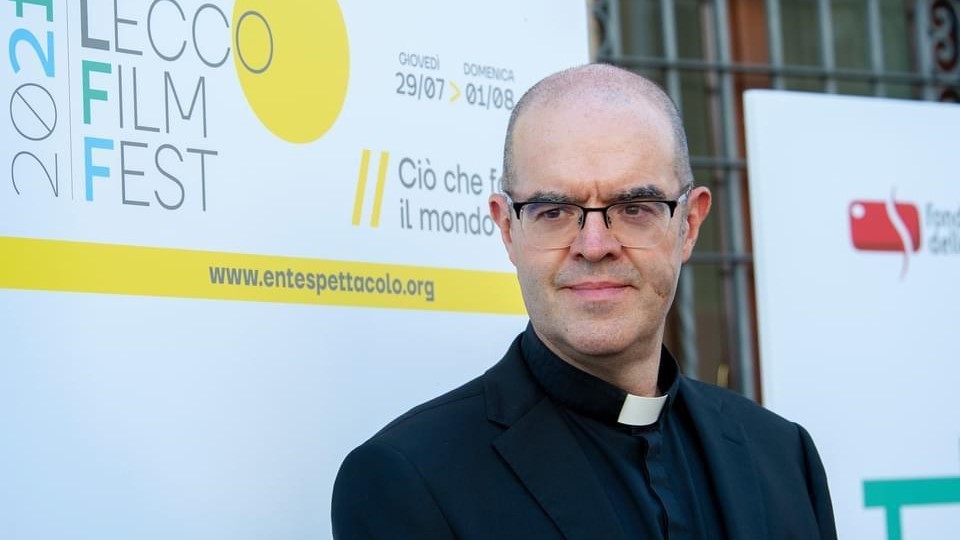Monsignor Milani: “Through cinema we tell the story of Hope and let questions of meaning arise
From 14 to 21 April, the Cinema delle Provincie in Rome hosts the “Faces and Counterfaces of Hope” film festival in preparation for the 2025 Jubilee. One of the organizers of the initiative, for the Dicastery for Evangelization, is Monsignor Davide Milani, president of the Ente del Cinema Foundation.
Monsignor Milani, why organise a film festival in preparation for the Holy Year?
“The challenge set by the Pro-prefect of the Dicastery for Evangelization, Archbishop Fisichella, was to think about the theme of Hope, with the motto "Pilgrims of Hope", not only at an internal Church level, but trying also to open up, as the Pope asks, to the whole world. The Jubilee is a universal event, and the languages of art, and in particular that of cinema, are platforms in which we can dialogue with everyone. It is an experience in which belief or non-belief is not seen as a dividing wall. It is no longer a barrier, because cinema puts everyone on the same level, it creates an opportunity for encounter in which we are all sitting in front of the same screen at the same distance. In the cinema we all have the same experience: we are listeners. Cinema then, especially when we are talking about a film d’auteur, poses reflections and questions, recounts experiences. We are in a period of history in which everyone offers answers to everything, but the task of art and cinema is to raise questions to make the spectator reflect on how he is living, on what he is looking for in life. It is only through questions that we arrive at the Gospel, through questioning we arrive at the proposal of Jesus Christ. So, cinema has that ability, and the films chosen for the festival point in that direction."
So, why did you choose these 12 films?
“We tried to focus on recent cinematography, with the occasional excursus into films that are a bit older. Hope is the common thread, just think of the title of the exhibition, "Faces and Counterfaces of Hope". If I think of "One Life" by James Hawes, for example, it has the figure of this elderly Englishman who was the protagonist in the rescue of Jewish children destined for concentration camps in occupied Czechoslovakia. Here he embodied hope for many people, he took a risk on his own. Think of "La Chimera" by Alice Rohrwacher, where in a corrupt world, attached only to the materiality of things, the young archaeologist Arthur tries to restore the spiritual value to objects stolen from under the ground, in a way that goes far beyond any link to money. In his searching among the Etruscan tombs, he experiences something of the search for reunion with the woman he loves who has died. In "Chiara" there is the figure of a girl, in a society in which the role of women was marginal, who embodies the desire for a new community, for a new form of female activity, for a renewed church. The common trait of these films is the story of a Hope which is not the expectation of something that will drop magically from the heavens like rain, but rather a reality to which every man and woman aspires and to which they long to anchor themselves."
What is the role of imagery in transmitting a value such as hope?
“The power of cinema is that it tells a story, it places the spectator inside another person's experience, in which one can recognize oneself either by similarity to the characters or by distance from them. The power of cinema is that it combines music, literature, and photography. All these languages find a synthesis in cinema, it is a very penetrating language. Cinema is, in a way, the novel of modernity, It is impossible to explain what we are and what we have experienced without cinema. It is the black box of the time we have lived through, a popular language which can be understood by everyone with a minimum access threshold, it is within everyone's reach. There are, of course, those who are experts and know how to pick out specific quotes, but when watching a film everyone can feel involved. Cinema is a bearer of hope because it is a universal language. Of course, for us Christians, Christ is the incarnation of Hope, which has opened us to eternal life, but even those who do not believe have hope. Everyone needs hope, and cinema, in its wide range of stories, tries to express that hope."
You are president of the Fondazione Ente dello spettacolo, established in 1947 to promote cinematographic culture in Italy by mandate of the Italian Bishops’ Conference. What are its aims and objectives?
“The objective is to talk about quality cinema, cinema that really makes you think, that makes you dialogue, that expresses such emotions as hope, pain, and love. In short, not a cinema which is pure entertainment, but rather a cinema which puts people on a journey, which brings added value, which creates community and tries to express what cannot always be seen. Ours is therefore not a strictly confessional role, we are not here to promote ‘Catholic cinema’ but all cinema that has a soul."


